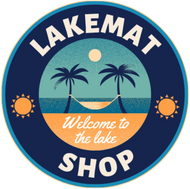“Doing nothing” can be considered a type of lake weed management technique. We understand and often agree with those who feel leaving it up to nature is the best alternative. But the unintended consequences of non-action can lead to severe environmental problems that become difficult and expensive to manage.
Nonnative, invasive aquatic plants are the real problem.
“I can’t fix this”
I met a group of homeowners on a private 12-acre lake. They’d all built homes about the same time 12 years earlier. They had photos of what once was their beautiful little lake. It was postcard perfect… Perfect, 12-years before.
A few white lilies grew in a couple small clusters. Half of the owners wanted to get rid of them, and half thought they were “pretty” and wanted them left alone. So as a group, they did nothing.
When I arrived, there was one small area of open water in the middle, maybe just three or four acres. Most of the once-pristine lake was completely choked with white lilies. No one could swim or get their boats out. Their lake had become unusable.
“I can’t fix this,” I told them. “This has to be professionally treated with herbicide, or completely dredged, or both.” By doing nothing, the residents had created a problem that would take a lot of money and time to correct.
“What’s up with that weed harvester?”
I visited my brother Dick, on a big lake in Florida. In the distance I saw a weed harvester going up a canal.
“What’s up with that weed harvester?” I asked.
“Everyone chipped in and bought it so we can all get out into the lake,” he said. “They’re doing our canal next. Come here, I’ll show you.”
Dick’s place was on a canal close to the lake. When we got to his dock I was shocked. His entire canal was choked with hydrilla. Out in the lake I could see hydrilla spanning out over 100 yards. A solid mass of one of the worlds most invasive weeds with stems that can grow one inch per day, per stem! It can grow in water up to 20 feet deep. It’s the stuff of nightmares.
They residents needed the weed harvester to cut paths to open water. Otherwise they could no longer use their lake.
Nonnative plants are biological pollutants that wreak havoc on water bodies.
Left unchecked, they overwhelm and destroy native ecosystems. Ask any property owner where hydrilla, water lilies, purple loosestrife, parrot feather or starry stonewart has taken over their lake.
Doing nothing is not an answer
There is no single solution to aquatic plant problems, no “one size fits all” solution. For large areas, aquatic herbicides are the most practical. For clearing weeds (that don’t spread by fragmentation,) physical removal can work. Lakebed agitators like blowers and weed rollers will work in small areas, (just don’t overdo it). Dredging is effective in lakes that have filled in with sediment.
More exotic techniques such as weed-eating fish and insects have had some success in reducing invasive aquatic plants.
Our LakeMat Pro and MuckMat Pro are chemical-free and 100% effective in eliminating lake weeds for individual lakefronts. They don’t create more weeds by fragmentation. Being gas- and water-permeable, they allow your lake bottom to “breath,” so the microorganisms that keep your lake clean are unaffected.
None of these techniques are without flaws. But in most cases, “doing something” is always better than doing nothing to control invasive aquatic weeds.
Note:
LakeMat Pros are for lake weeds only.
MuckMat Pros are for both lake weeds and a firmer lake bottom.












leave a comment